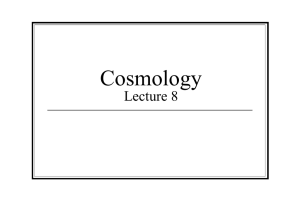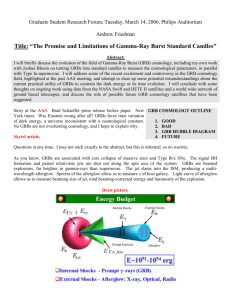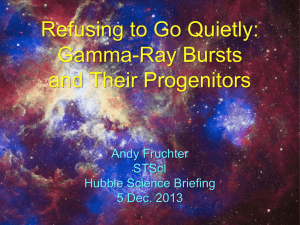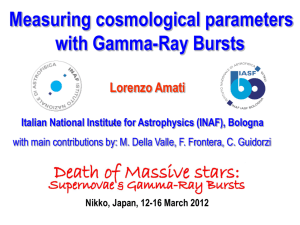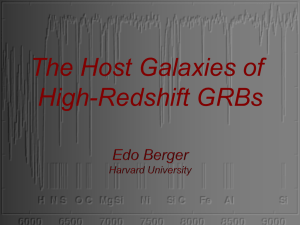Lorenzo Amati
advertisement
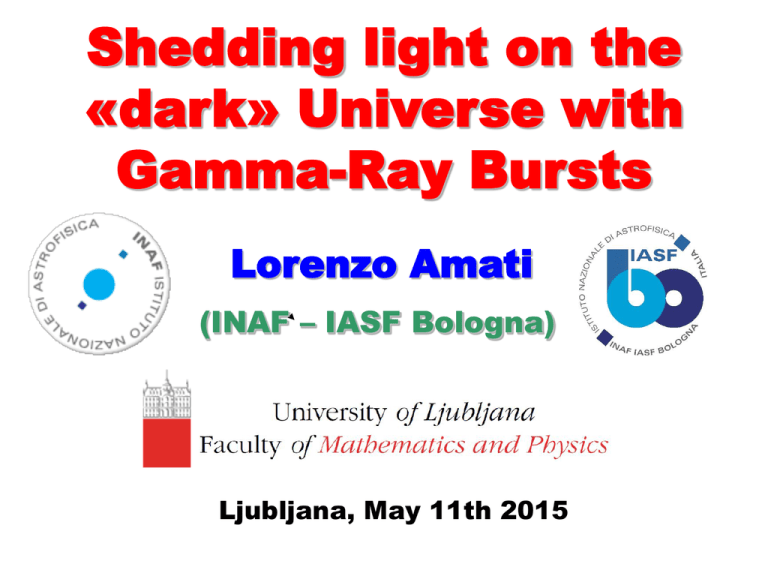
Shedding light on the «dark» Universe with Gamma-Ray Bursts Lorenzo Amati (INAF – IASF Bologna) Ljubljana, May 11th 2015 Gamma-Ray Bursts are the most luminous and remote phenomena in the Universe, with isotropic-equivalent radiated energies in X-gamma rays up to more than 1054 erg released in a few tens of seconds and a redshift distribution extending to at least z = 9-10. Thus, they are in principle very powerful tools for cosmology Part 1: status and perspectives of the research activities aimed at using GRBs to investigate the expansion rate and geometry of the Universe, thus getting clues to "dark energy" properties and evolution Part 2: GRBs as tools for exploring the early Universe at the end of the "dark ages" (reionization, first stars, star formation rate and metallicity evolution in the first billion of years) – the THESEUS mission concept Gamma-Ray Bursts are the most luminous and remote phenomena in the Universe, with isotropic-equivalent radiated energies in X-gamma rays up to more than 1054 erg released in a few tens of seconds and a redshift distribution extending to at least z = 9-10. Thus, they are in principle very powerful tools for cosmology Part 1: status and perspectives of the research activities aimed at using GRBs to investigate the expansion rate and geometry of the Universe, thus getting clues to "dark energy" properties and evolution Part 2: GRBs as tools for exploring the early Universe at the end of the "dark ages" (reionization, first stars, star formation rate and metallicity evolution in the first billion of years) – the THESEUS mission concept The accelerating and “dark” Universe the standard “hot big-bang” cosmological model as of middle ’90s (general relativity + Hubble law + cosmological principle + dark matter + CMB) The accelerating and “dark” Universe the standard “hot big-bang” cosmological model as of middle ’90s (general relativity + Hubble law + cosmological principle + dark matter + CMB) the standard “hot big-bang” cosmological model NOW: inflation + CMB -> ~ flat Universe (Wtot = 1), SN Ia (+ clusters, BAO) -> Wm ~0.3 -> accelerated espansion + dark energy (cosmological constant, quintessence, …) the Universe expansion is accelerating Universe now expanding ~20% faster than 5 billion years ago XX g Decelerating, then accelerating universe the Universe is “dark” Courtesy: Prof. Capozziello (Università Federico II Napoli) Courtesy: Prof. Capozziello (Università Federico II Napoli) Measuring cosmological parameters Standard candles (e.g., Cepheids, very low redshift) + “standardized” sources (e.g., SN Ia) + large scale structure evolution (galaxies, clusters -> BAO) + CMB (matter-energy and space-time fluctuations at z ~1100, inflation) e.g., standard candles: a population of unevolving sources, having a fixed intrinsic luminosity DL 1 z c H o | k | S | k | 0.5 0.5 k 1 z z 0 2 0.5 3 WM 1 z' W dz' m M 5 log[ DL( z; WM ; W)] K 25 A Measuring cosmological parameters Standard candles (e.g., Cepheids, very low redshift) + “standardized” sources (e.g., SN Ia) + large scale structure evolution (galaxies, clusters -> BAO) + CMB (matter-energy and space-time fluctuations at z ~1100, inflation) e.g., EUCLID (> 2020) will investigate the distance-redshift relationship and the evolution of cosmic structures by measuring shapes and redshifts of galaxies and clusters of galaxies out to redshifts ~2, or equivalently to a look-back time of 10 billion years Why looking for more cosmological probes ? different distribution in redshift -> different sensitivity to different cosmological parameters DL 1 z c H o | k | S | k | 0.5 0.5 k 1 z z 0 2 0.5 3 WM 1 z ' W dz ' Guy et al. 2010 Astier et al. 2006 Recent results from SNLS (231 SNe Ia at 0.15 < z < 1.1, Guy et al. 2010) compared to those of Astier et al. 2006 (44 low redshift SNe along with the 71 SNe from the SNLS first year sample) Each cosmological probe is characterized by possible systematics e.g SN Ia: different explosion mechanism and progenitor systems ? May depend on z ? light curve shape correction for the luminosity normalisation may depend on z signatures of evolution in the colours correction for dust extinction anomalous luminosity-color relation contaminations of the Hubble Diagram by no-standard SNe-Ia and/or bright SNe-Ibc (e.g. HNe) If the “offset from the truth” is just 0.1 mag…. (slide by M. della Valle) The Gamma-Ray Burst phenomenon sudden and unpredictable bursts of hard-X / soft gamma rays with huge flux most of the flux detected from 10-20 keV up to 1-2 MeV, with fluences typically of ~10-7 – 10-4 erg/cm2 and bimodal distribution of duration measured rate (by an all-sky experiment on a LEO satellite): ~0.8 / day; estimated true rate ~2 / day short long Early evidences for a cosmological origin of GRBs isotropic distribution of GRBs directions paucity of weak events with respect to homogeneous distribution in euclidean space given the high fluences (up to more than 10-4 erg/cm2 in 20-1000 keV) a cosmological origin would imply huge luminosity thus, a “local” origin was not excluded until 1997 ! Establishing the GRBs cosmological distance scale in 1997 discovery of afterglow emission by BeppoSAX prompt afterglow (observational gap between “prompt” and “afterglow emission” will be filled by Swift in > 2004) ~ -3 ( 1 min ≤ t ≤ hours ) 10^5 – 10^6 s ~ -0.7 ~ - 1.3 10^2 – 10^3 s10^4 – 10^5 s Swift team ~ -2 1997: accurate (a few arcmin) and quick localization of X-ray afterglow -> optical followup -> first optical counterparts and host galaxies -> GRB-SN connection: GRB 980425, a normal GRB detected and localized by WFC and NFI, but in temporal/spatial coincidence with a type Ib/c SN at z = 0.008 bumps in optical afterglow light curves and optical spectra resembling that of GRB980425 Galama et al. 1998, Hjorth et al. 2003 1997: accurate (a few arcmin) and quick localization of X-ray afterglow -> optical follow-up -> first optical counterparts and host galaxies optical spectroscopy of afterglow and/or host galaxy –> first measurements of GRB redshift redshifts higher than 0.01 and up to > 8: GRB are cosmological ! their isotropic equivalent radiated energy is huge (up to more than 1054 erg in a few tens of s !) GRB COSMOLOGY ? fundamental input for origin of long / short Are Gamma-Ray Bursts standard candles ? all GRBs with measured redshift (~320, including a few short GRBs) lie at cosmological distances (z = 0.033 – ~9.3) (except for the peculiar GRB980425, z=0.0085) isotropic luminosities and radiated energy are huge, can be detected up to very high z no dust extinction problems; z distribution much beyond SN Ia but… GRBs are not standard candles (unfortunately) Jakobsson et al., 2010 Amati, 2009 jet angles, derived from break time of optical afterglow light curve by assuming standard scenario, are of the order of few degrees the collimation-corrected radiated energy spans the range ~5x1049 – 5x1052 erg-> more clustered but still not standard Ghirlanda et al., 2004 GRB have huge luminosity, a redshift distribution extending far beyond SN Ia high energy emission -> no extinction problems Ghirlanda et al, 2006 GRB have huge luminosity, a redshift distribution extending far beyond SN Ia high energy emission -> no extinction problems potentially powerful cosmological sources but need to investigate their properties to find ways to standardize them (if possible) Ghirlanda et al, 2006 The Ep,i – Eiso correlation GRB spectra typically described by the empirical Band function with parameters a= lowenergy index, b= high-energy index, E0=break energy Ep = E0 x (2 + a) = peak energy of the nFn spectrum Ep since 1997: measured spectrum + measured redshift -> intrinsic peak enery Ep,i and radiated energy, average luminosity, peak luminosity lack of firm information on jet-opening angles -> use of isotropic-equivalent intensity indicators (Eiso, Liso, Lp,iso) Ep,i = Ep x (1 + z) 190 GRB Ep Jakobsson (2009) Amati et al. (A&A 2002): significant correlation between Ep,i and Eiso found based on a small sample of BeppoSAX GRBs with known redshift BeppoSAX GRBs Ep,i – Eiso correlation for GRBs with known redshift confirmed and extended by measurements of ALL other GRB detectors with spectral capabilities 130 long GRBs as of Sept. 2011 BeppoSAX GRBs Ep,i – Eiso correlation for GRBs with known redshift confirmed and extended by measurements of ALL other GRB detectors with spectral capabilities 162 long GRBs as of June 2013 Swift GRBs strong correlation but significant dispersion of the data around the best-fit power-law; distribution of residuals can be fit with a Gaussian with s(logEp,i) ~ 0.2 the “extra-statistical scatter” of the data can be quantified by performing a fit whith a max likelihood method (D’Agostini 2005) which accounts for sample variance and the uncertainties on both X and Y quantities with this method Amati et al. (2008, 2009) found an extrinsic scatter sint(logEp,i) ~ 0.18 and index and normalization t ~0.5 and ~100, respectively Correlation of Ep,i with other “intensity” indicators the correlation holds also when substituting Eiso with Liso (e.g., Lamb et al. 2004) or Lpeak,iso (Yonetoku et al. 2004, Ghirlanda et al., 2005) this is expected because Liso and Lpeak,iso are strongly correlated with Eiso w/r to Eiso, Lp,iso is subject to more uncertainties (e.g., light curves peak at different times in different energy bands; spectral parameters at peak difficult to estimate; which peak time scale ?) Nava et al. 2009 Correlation of Ep,i with other “intensity” indicators the correlation holds also when substituting Eiso with Liso (e.g., Lamb et al. 2004) or Lpeak,iso (Yonetoku et al. 2004, Ghirlanda et al., 2005) this is expected because Liso and Lpeak,iso are strongly correlated with Eiso w/r to Eiso, Lp,iso is subject to more uncertainties (e.g., light curves peak at different times in different energy bands; spectral parameters at peak difficult to estimate; which peak time scale ?) Correlation of Ep,i with other “intensity” indicators the correlation holds also when substituting Eiso with Liso (e.g., Lamb et al. 2004) or Lpeak,iso (Yonetoku et al. 2004, Ghirlanda et al., 2005) this is expected because Liso and Lpeak,iso are strongly correlated with Eiso w/r to Eiso, Lp,iso is subject to more uncertainties (e.g., light curves peak at different times in different energy bands; spectral parameters at peak difficult to estimate; which peak time scale ?) Nava et al. 2009 Amati, Frontera & Guidorzi (2009): the normalization of the correlation varies only marginally using measures by individual instruments with different sensitivities and energy bands: -> no relevant selection effects Amati , Frontera & Guidorzi 2009 Amati, Frontera & Guidorzi (2009): the normalization of the correlation varies only marginally using measures by individual instruments with different sensitivities and energy bands: -> no relevant selection effects Amati & Della Valle 2013 the Ep,i– Liso and Ep,I – Eiso correlation holds also within a good fraction of GRBs (Liang et al.2004, Firmani et al. 2008, Ghirlanda et al. 2009, Li et al. 2012, Frontera et al. 2012, Basak et al. 2013): robust evidence for a physical origin and clues to explanation BATSE (Liang et al., ApJ, 2004) Fermi (e.g., Li et al. , ApJ, 2012) the Ep,i– Liso and Ep,I – Eiso correlation holds also within a good fraction of GRBs (Liang et al.2004, Firmani et al. 2008, Ghirlanda et al. 2009, Li et al. 2012, Frontera et al. 2012, Basak et al. 2013): robust evidence for a physical origin and clues to explanation BATSE (Liang et al., ApJ, 2004) Fermi (e.g., Li et al. , ApJ, 2012) the Ep,i– Liso and Ep,I – Eiso correlation holds also within a good fraction of GRBs (Liang et al.2004, Firmani et al. 2008, Ghirlanda et al. 2009, Li et al. 2012, Frontera et al. 2012, Basak et al. 2013): robust evidence for a physical origin and clues to explanation BATSE (Liang et al., ApJ, 2004) Fermi (e.g., Li et al. , ApJ, 2012) Implications: emission physics and geometry physics of prompt emission still not settled, various scenarios: SSM internal shocks, IC-dominated internal shocks, external shocks, photospheric emission dominated models, kinetic energy / Poynting flux dominated fireballs, … e.g., Ep,i G-2 L1/2 tn-1 for syncrotron emission from a power-law distribution of electrons generated in an internal shock (Zhang & Meszaros 2002, Ryde 2005) e.g., Ep,i G Tpk G2 L-1/4 in scenarios in whch for comptonized thermal emission from the photosphere dominates (e.g. Rees & Meszaros 2005, Thomson et al. 2006) jet geometry and structure and XRF-GRB unification models (e.g., Lamb et al. 2004) viewing angle effects: d=[g(1 - bcos(qv - Dq))]-1 , DEp d , DEiso d1a) (e.g, Yamazaki et al.) Uniform/variable jet Uniform/variable jet PL-structured PL-structured /universal jet /universal jet Uniform/iniversal jet + off-axis viewing Lamb et al. 2005 Yamazaki et al. 2004 Implications: sub-classes of GRBs Sept. 2012 Ep,i – Eiso plane: 148 long GRBs, 4 XRFs, 13 short GRBs Different behaviour of short GRBs in the Ep,i – Eiso and Ep,i – Lp,iso planes (e.g., Ghirlanda et al. 2011, Zhang et al. 2012, Tsutsui et al. 2012) estimates and limits on Ep,i and Eiso are inconsistent with Ep,i-Eiso correlation holding for long GRBs low Eiso values and high lower limits to Ep,i indicate inconsistency also for the other short GRBs long weak soft emission in some cases, consistent with the Ep,i – Eiso correlations GRB0050724 “Standardizing” GRB with the Ep,i - Intensity correlation Ep,i = Ep,obs x (1 + z) Dl = Dl (z , H0 , WM , W ,…) not enough low-z GRBs for cosmology-independent calibration -> circularity is avoided by fitting simultaneously the parameters of the correlation and cosmological parameters does the extrinsic scatter and goodness of fit of the Ep,i-Eiso correlation vary with the cosmological parameters used to compute Eiso ? a fraction of the extrinsic scatter of the Ep,i-Eiso correlation is indeed due to the cosmological parameters used to compute Eiso Evidence, independent on SN Ia or other cosmological probes, that, if we are in a flat CDM universe , WM is lower than 1 and around 0.3 Simple PL fit Amati et al. 2008, 2013 By using a maximum likelihood method the extrinsic scatter can be parametrized and quantified (e.g., Reichart 2001) WM could be constrained (Amati+08, 70 GRBs) to 0.04-0.43 (68%) and 0.020.71 (90%) for a flat CDM universe (WM = 1 excluded at 99.9% c.l.) Amati et al. 2008, 2013 analysis of updated sample of 137 GRBs (Amati+12) shows significant improvements w/r to the sample of 70 GRBs of Amati et al. (2008) this evidence supports the reliability and perspectives of the use of the Ep,i – Eiso correlation for the estimate of cosmological parameters Wm (flat universe) best 68% 90% 70 GRBs (Amati+ 08) 0.27 0.09 – 0.65 0.05 – 0.89 137 GRBs (Amati+ 12) 0.29 0.12 – 0.54 0.08 – 0.79 70 GRBs 114GRBs GRBs 137 GRB Perspectives present and near future: main contribution expected from joint Fermi + Swift measurements Up to 2009: ~290 Fermi/GBM GRBs, Ep estimates for ~90%, ~35 simultaneously detected by Swift (~13%), 13 with Ep and z estimates (~10% of Swift sample) 2008 pre-Fermi : 61 Swift detections, 5 BAT Ep (8%), 15 BAT + KONUS + SUZAKU Ep estimates (25%), 20 redshift (33%), 11 with Ep and z estimates (~15% of Swift sample) Fermi provides a dramatic increase in Ep estimates (as expected), but a only small fraction of Fermi GRBs is detected / localized by Swift (~15%) -> low number of Fermi GRBs with Ep and z (~5%). Summary: 15-20 GRB/year in the Ep,i – Eiso plane In the > 2020 time frame a significant step forward expected from SVOM (+ UFFO, CALET/GBM ?) spectral study of prompt emission in 5-5000 keV -> accurate estimates of Ep and reduction of systematics (through optimal continuum shape determination and measurement of the spectral evolution down to X-rays) fast and accurate localization of optical counterpart and prompt dissemination to optical telescopes -> increase in number of z estimates and reduction of selection effects optimized for detection of XRFs, short GRB, subenergetic GRB, high-z GRB substantial increase of the number of GRB with known z and Ep -> test of correlations and calibration for their cosmological use Enlargement of the sample (+ self-calibration) the simulatenous operation of Swift, Fermi/GBM, Konus-WIND is allowing an increase of the useful sample (z + Ep) at a rate of 20 GRB/year, providing an increasing accuracy in the estimate of cosmological parameters future GRB experiments (e.g., SVOM) and more investigations (in particular: reliable estimates of jet angles and self-calibration) will improve the significance and reliability of the results and allow to go beyond SN Ia cosmology (e.g. investigation of dark energy) Amati & Della Valle 2013 Enlargement of the sample (+ self-calibration + reliable jet angles) the simulatenous operation of Swift, Fermi/GBM, Konus-WIND is allowing an increase of the useful sample (z + Ep) at a rate of 20 GRB/year, providing an increasing accuracy in the estimate of cosmological parameters future GRB experiments (e.g., SVOM) and more investigations (in particular: reliable estimates of jet angles and self-calibration) will improve the significance and reliability of the results and allow to go beyond SN Ia cosmology (e.g. investigation of dark energy) Amati et al. 2015 Accounting for collimation 2004: evidence that by substituting Eiso with the collimation corrected energy Eg the logarithmic dispersion of the correlation decreases significantly and is low enough to allow its use to standardize GRB (Ghirlanda et al., Dai et al, and many) Accounting for collimation: perspectives the simulatenous operation of Swift, Fermi/GBM, Konus-WIND is allowing an increase of the useful sample (z + Ep) at a rate of 20 GRB/year, providing an increasing accuracy in the estimate of cosmological parameters future GRB experiments (e.g., SVOM) and more investigations (physics, methods, calibration) will improve the significance and reliability of the results and allow to go beyond SN Ia cosmology (e.g. investigation of dark energy) Adapted from Ghirlanda+ 2007 Accounting for collimation: drawbacks the Ep-Eg correlation is model dependent: slope depends on the assumptions on the circum-burst environment density profile (ISM or wind) addition of a third observable introduces further uncertainties (difficulties in measuring t_break, chromatic breaks, model assumptions) and substantially reduces the number of GRB that can be used (e.g., #Ep,i – Eg ~ ¼ #Ep,i – Eiso ) ISM Nava et al.. , A&A, 2005: ISM (left) and WIND (right) WIND lack of jet breaks in several Swift X-ray afterglow light curves, in some cases, evidence of achromatic break challenging evidences for Jet interpretation of break in afterglow light curves or due to present inadequate sampling of optical light curves w/r to X-ray ones and to lack of satisfactory modeling of jets ? Calibrating the Ep,i – Eiso correlation with SN Ia Several authors (e.g., Kodama et al., 2008; Liang et al., 2008, Li et al. 2008, Demianski et al. 2010-2011, Capozziello et al. 2010, Wang et al. 2012) are investigating the calibration of the Ep,i - Eiso correlation at z < 1.7 by using the luminosity distance – redshift relation derived for SN Ia The aim is to extend the SN Ia Hubble diagram up to redshifts at which the luminosity distance is more sensitive to dark energy properties and evolution Drawback: with this method GRB are no more an indipendent cosmological probe Kodama et al. 2008 Amati & Della Valle 13, Amati+ 13 Calibrating the Ep,i – Eiso correlation with SN Ia Several authors (e.g., Kodama et al., 2008; Liang et al., 2008, Li et al. 2008, Demianski et al. 2010-2011, Capozziello et al. 2010, Wang et al. 2012) are investigating the calibration of the Ep,i - Eiso correlation at z < 1.7 by using the luminosity distance – redshift relation derived for SN Ia The aim is to extend the SN Ia Hubble diagram up to redshifts at which the luminosity distance is more sensitive to dark energy properties and evolution Drawback: with this method GRB are no more an indipendent cosmological probe Kodama et al. 2008 Amati & Della Valle 2013, Amati+ 2013 SNe-Ia The GRB Hubble diagram extends to much higher z w/r to SNe Ia The GRB Hubble diagram is consistent with SNe Ia Hubble diagram at low redshifts: reliability GRB Conclusions - 1 Given their huge radiated energies and redshift distribution extending from ~ 0.1 up to > 9, GRBs are potentially a very powerful cosmological probe, complementary to other probes (e.g., SN Ia, clusters, BAO) The Ep,i – intensity correlation is one of the most robust (no firm evidence of significant selection / instrumental effects) and intriguing properties of GRBs and a promising tool for cosmological parameters Analysis in the last years (>2008) provide already evidence, independent on , e.g., SN Ia, that if we live in a flat CDM universe, Wm is < 1 at >99.9% c.l. (c2 minimizes at Wm ~ 0.3, consistent with “standard” cosmology) The simulatenous operation of Swift, Fermi/GBM, Konus-WIND is allowing an increase of the useful sample (z + Ep) at a rate of 15-20 GRB/year, providing an increasing accuracy in the estimate of cosmological parameters Future GRB experiments and investigations (physics, collimation, calibration) will allow to go beyond SN Ia (e.g.,dark energy EOS) Gamma-Ray Bursts are the most luminous and remote phenomena in the Universe, with isotropic-equivalent radiated energies in X-gamma rays up to more than 1054 erg released in a few tens of seconds and a redshift distribution extending to at least z = 9-10. Thus, they are in principle very powerful tools for cosmology Part 1: status and perspectives of the research activities aimed at using GRBs to investigate the expansion rate and geometry of the Universe, thus getting clues to "dark energy" properties and evolution Part 2: GRBs as tools for exploring the early Universe at the end of the "dark ages" (reionization, first stars, star formation rate and metallicity evolution in the first billion of years) – the THESEUS mission concept Gamma-Ray Burst as powerful probes of the early Universe Because of their huge luminosities, mostly emitted in the X and gammarays, their redshift distribution extending at least to z ~10 and their association with explosive death of massive stars and star forming regions, GRBs are unique and powerful tools for investigating the early Universe: SFR evolution, physics of re-ionization, galaxies metallicity evolution and luminosity function, first generation (pop III) stars A statistical sample of high–z GRBs can provide fundamental information about: • measure independently the cosmic star–formation rate, even beyond the limits of current and future galaxy surveys Robertson&Ellis12 Z = 9.2 • the number density and properties of low-mass galaxies z=6.29; MAB > 28.86 Z=5.11; MAB > 28.13 Z=5.47; MAB > 28.57 Z=6.73; MAB > 27.92 Z=8.23; MAB > 30.29 Z=9.4; MAB > 28.49 Tanvir+12 Robertson&Ellis12 Even JWST and ELTs surveys will be not able to probe the faint end of the galaxy Luminosity Function at high redshifts (z>6-8) Abundances, HI, dust, dynamics etc. even for very faint hosts. E.g. GRB 050730: faint host (R>28.5), but z=3.97, [Fe/H]=-2 and low dust, from afterglow spectrum (Chen et al. 2005; Starling et al. 2005). Forest (IGM) Metals HST/ACS Ly-limit HI(Lya) The first, metal–free stars (the so–called PopIII stars) can result in powerful GRBs (e.g. Meszaros+10). GRBs offer a powerful route to directly identify such elusive objects (even JWST will not be able to detect them directly) and study the galaxies in which they are hosted. Even indirectly, the role of PopIII stars in enriching the first galaxies with metals can be studied by looking to the absorption features of PopII GRBs blowing out in a medium enriched by the first PopIII supernovae (Wang+12). Neutral fraction of the IGM More generally, what is the cosmic chemical evolution at early times? Chornock+14 72 THESEUS Transient High Energy Sources and Early Universe Surveyor Lead Proposer: Lorenzo Amati (INAF – IASF Bologna, Italy) M4 proposal coordinators: Lorenzo Amati, Paul O’Brien (Univ. Leicester, UK), Diego Gotz (CEA-Paris, France), Alberto Castro-Tirado (IAA, Spain) Payload consortium: Italy, UK, Spain, Denmark, Poland, Czech Republic, ESA (+ France, Hungary, Slovenia, Ireland) International partners: USA (+ interest from Brasil, Japan, Israel, Turkey) Main scientific goals Exploring the Early Universe (cosmic dawn and reionization era) by unveiling the Gamma-Ray Burst (GRBs) population in the first billion years The study of the Universe before and during the epoch of reionization represents one of the major themes for the next generation of space and ground–based observational facilities. Many questions about the first phases of structure formation in the early Universe will still be open in the late 2020s: • When and how did first stars/galaxies form? • What are their properties? When and how fast was the Universe enriched with metals? • How did reionization proceed? Planck THESEUS EUCLID 79 THESEUS payload • Soft X-ray Imager (SXI): a set of « Lobster-Eye » X-ray (0.3 - 6 keV) telescopes covering a total FOV of 1 sr field with 0.5 – 1 arcmin source location accuracy, provided by a UK led consortium (+ Czech Repubblic) • InfraRed Telescope (IRT): a 70 cm class near-infrared (up to 2 microns) telescope (IRT) with imaging and moderate spectral capabilities provided by a Spanish led consortium (+ ESA, + Ireland ?) • X-Gamma-rays Spectrometer (XGS): non-imaging spectrometer (XGS) based on SDD+CsI, covering the same FOV than the Lobster telescope extending its energy band up to 20 MeV. This instrument will be provided by an Italian led consortium (+USA ?) • Payload Data Handling System (PDHS): Poland led consortium (+ Denmark, Finland) Ghirlanda et al. 2015 The Soft X-ray Imager (SXI) The Soft X-ray Imager (SXI) The X-Gamma-rays spectrometer (XGS) • In order to efficiently classify and filter the triggers (no previous experience had such a sensitivity in soft X-rays on a wide FOV), a broad band spectral coverage is needed at high energies (in addition the GRB phenomenon will be better characterized) • Finally the GRB information has to be down-linked to Earth for rapid follow-up by large ground based facilities (e.g. molecules, line fine structure, etc.) The InfraRed Telescope (IRT) • In order to identify, classify and study the high-z GRB counterparts, an near-infrared (due to cosmological Ly-alpha suppression) telescope is needed on board. It will provide accurate positions, GRB redshifts, and GRB afterglows spectra (R~1000). • The telescope shall be of the 0.5-1 m class in order to be able to detect the sources with the expected flux. Note that any ground based facility will not have the same efficiency and/or sensitivity in following-up 1000 bursts per year that are needed in order to have a few tens of GRBs beyond z=8. • An agile and autonomous platform (Swift-like) is required in order to point at the GRB position quickly + Infrared telescope and fast slewing !!! THESEUS 3 years Swift 10 years Ghirlanda + Salvaterra N. Tanvir N. Tanvir The first, metal–free stars (the so–called PopIII stars) can result in powerful GRBs (e.g. Meszaros+10). GRBs offer a powerful route to directly identify such elusive objects (even JWST will not be able to detect them directly) and study the galaxies in which they are hosted. Even indirectly, the role of PopIII stars in enriching the first galaxies with metals can be studied by looking to the absorption features of PopII GRBs blowing out in a medium enriched by the first PopIII supernovae (Wang+12). Neutral fraction of the IGM More generally, what is the cosmic chemical evolution at early times? Chornock+14 104 Additional Science: performing an unprecedented deep survey of the soft X-ray transient Universe • • • Fill the present gap in the discovery space of new classes of transients events, thus providing unexpected phenomena and discoveries; Provide a fundamental step forward in the comprehension of the physics of various classes of Galactic and extra‐Galactic transients, like, e.g.: tidal disruption events TDE, magnetars/SGRs, SN shock break‐out, Soft X‐ray Transients SFXTS, thermonuclear bursts from accreting neutron stars, Novae, dwarf novae, stellar flares, AGNs / Blazars); Provide real time trigger and accurate (~1 arcmin within a few s) high‐energy transients for follow‐up with next generation optical, IR, radio, X‐rays, TeV or neutrino telescopes and identify electromagnetic counterpart of detections by next generation gravitational wave detectors. e.g.: X-Ray flashes and subluminous GRBs Discriminating among different models - The case of GRB 090618: THESEUS/XGS will be capable of discriminating among Band and BB+PL thanks to its energy band extending below 10 keV Fermi/GBM THESEUS/XGS (BB+PL) THESEUS /XGS (Band model) Absorption features: the case of GRB990705 (edge at 3.8 keV -> redshifted neutral iron k-edge -> z = 0.85 -> confirmed by host galaxy spectroscopy: redshift estimate through X-ray spectroscopy BeppoSAX WFC + GRBM THESEUS XGS investigating dark energy with GRBs 600 GRB investigating dark energy with GRBs 600 GRB Payload accomodation and budgets Mission profile • Launch with VEGA into LEO (< 5°, ~600 km) • Spacecraft slewing capabilities (30° < 4 min) • Pointing anti-sun + ~polar • Malindi antenna (+ Alcantara ?) • Prompt downlink options : NASA/TDRSS, ESA/EDRS, WHF network, IRIDIUM network, ORBCOMM • MOC, SOC -> ESA • SDC -> ASDC (+FSC) THESEUS payload consortium • ITALY - XGS + SDC (data archiving, AOs) + S/W (XGS pipeline) + Malindi antenna • UK - SXI (optics + detectors + calibration) + S/W (SXI pipeline and remote contribution to SDC) • Spain - IRT (coordination and IR camera, including cooler) , ESA - IRT optics • Poland + Denmark (+Finland ?) - Data Processing Units (DPU) for both SXI and XGS, Power Supply Units (PSU) • Czech Repubblic: contribution to mechanical structures and thermal control of SXI • USA: TDRSS, contrib. to XGS (and IRT detector ?), Brazil: Alcantara antenna (+ …. ?) • Other contributions / interest: Slovenia, Hungary, Ireland, Japan, Israel Conclusions -2 The relevance of GRB science for several fields of astrophysics, for cosmology, for the large observational facilities of the 2020s (EELT, SKA, JWST, ATHENA, CTA, gravitational waves and neutrino detectors) and the high experience and level of the European GRB community (science, observations and technology) strongly push for an ESA-led GRB oriented mission THESEUS (will be submitted to M5) will fully exploit GRBs as powerful and unique tools to investigate the early universe and will provide us with unprecedented clues to GRB physics and subclasses. The THESEUS proposal for ESA is a unique occasion for the worldwide GRB community. Contributions are very welcome from everybody willing to help; about 200 researcher from worldwide institutions already provided their support to THESEUS) Please, provide your support through the web page: http://goo.gl/forms/PFUfgjqNxG
